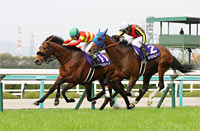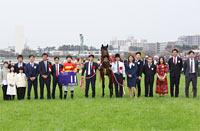Osaka Hai (G1) - Data Analysis
Spring middle-distance race for older horses that favors runners with track record of success
The Osaka Hai was upgraded to G1 status in 2017. Five of the six Top 3 finishers since (excluding third-place finisher Yamakatsu Ace in 2017) had previously finished in the Top 2 of a G1 race. Incidentally, Yamakatsu Ace had previously won three G2 races and two G3 races. Will runners that have notched wins in previous major races deliver another strong showing this year? Or will a new name emerge to upset the competitive landscape in G1 races for older horses. Let’s now analyze some features shared by successful runners in this race based on results over the last 10 years, including the period up to 2016, when the Osaka Hai was held as a G2 race under the name Sankei Osaka Hai.
Younger horses achieve better success ratios
Looking at performances by runners over the last 10 years in terms of age, horses aged “8” and “9” were all beaten to 4th or lower. In addition, when comparing success ratios, we find that the highest win ratio, Top 2 ratio, and Top 3 ratio were achieved by (in descending order) horses aged “4,” “5,” “6,” and “7.” In other words, younger horses should be rated more highly. [Table 1]
[Table 1] Performance by age (last 10 years)
| Age |
Performance
[1st-2nd-3rd-4th or lower] |
Win ratio |
Top 2 ratio |
Top 3 ratio |
| 4 |
5-4-3-19 |
16.1% |
29.0% |
38.7% |
| 5 |
4-3-2-22 |
12.9% |
22.6% |
29.0% |
| 6 |
1-2-5-27 |
2.9% |
8.6% |
22.9% |
| 7 |
0-1-0-16 |
0% |
5.9% |
5.9% |
| 8 |
0-0-0-11 |
0% |
0% |
0% |
| 9 |
0-0-0-3 |
0% |
0% |
0% |
Watch “grade” of previous race
Of the 30 Top 3 finishers over the last 10 years, 27 had contested a “G1/G2/top-level dirt race,” including a NAR or overseas race, in their previous race. Conversely, runners that had contested a “race other than G1/G2/top-level dirt race” struggled with a Top 3 ratio of 6.3%. When comparing the lead-up races of this year’s runners, we should focus on runners most recently seen in higher grade races. [Table 2]
[Table 2] Performance by grade of previous race (last 10 years)
Grade of
previous race |
Performance
[1st-2nd-3rd-4th or lower] |
Win ratio |
Top 2 ratio |
Top 3 ratio |
| G1/G2/top-level dirt race |
9-8-10-53 |
11.3% |
21.3% |
33.8% |
Race other than
G1/G2/top-level dirt race |
1-2-0-45 |
2.1% |
6.3% |
6.3% |
Note: Including NAR and overseas races.
Expect little from runners that suffered a major defeat last time out
The 30 Top 3 finishers over the last 10 years all finished their previous race “7th or higher.” In other words, we need to discount runners that were beaten to “8th or lower” in their previous race. [Table 3]
[Table 3] Performance by finish in previous race (last 10 years)
| Finish in previous race |
Performance
[1st-2nd-3rd-4th or lower] |
Win ratio |
Top 2 ratio |
Top 3 ratio |
| 7th or higher |
10-10-10-61 |
11.0% |
22.0% |
33.0% |
| 8th or lower |
0-0-0-37 |
0% |
0% |
0% |
Strong performance by runners that enjoyed success in major race held in previous year
Of the 30 Top 3 finishers over the last 10 years, 23 had experience finishing in the Top 5 of a “JRA 2,000m+ G1 or top-level dirt race held in the previous year.” Conversely, runners without such experience struggled with a Top 3 ratio of 8.8%. Incidentally, if we limit our analysis to the six years from 2013, these runners achieved a Top 3 ratio of 4.7% with performance of [0-1-1-41] and produced zero winners. When looking at the track record of this year’s runners, those that enjoyed success in a major race held in the previous year should be rated highly. [Table 4]
[Table 4] Performance by experience of finishing in Top 5 of “JRA 2,000m+ G1 or top-level dirt race held in the previous year” (last 10 years)
| Experience |
Performance
[1st-2nd-3rd-4th or lower] |
Win ratio |
Top 2 ratio |
Top 3 ratio |
| Yes |
8-6-9-25 |
16.7% |
29.2% |
47.9% |
| No |
2-4-1-73 |
2.5% |
7.5% |
8.8% |
Inner- and outermost brackets have produced little success in recent years
Of the 18 Top 3 finishers over the last six years, 16 entered the race with the numbers “3-9.” Conversely, runners that entered the race with the numbers “1, 2” were all beaten to 4th or lower, while runners that entered the race with the numbers “10-16” achieved a Top 3 ratio of only 8.3%. In the races up to 2012, runners that entered the race with the numbers “1, 2” or “10-16” performed well, but if trends in recent years are anything to go by, we should lower our expectations of runners that start the race in the inner- and outermost brackets. [Table 5]
[Table 5] Performance by horse number (last 6 years)
| Horse number |
Performance
[1st-2nd-3rd-4th or lower] |
Win ratio |
Top 2 ratio |
Top 3 ratio |
| 1 |
0-0-0-6 |
0% |
0% |
0% |
| 2 |
0-0-0-6 |
0% |
0% |
0% |
| 3 |
1-2-0-3 |
16.7% |
50.0% |
50.0% |
| 4 |
0-1-2-3 |
0% |
16.7% |
50.0% |
| 5 |
2-1-0-3 |
33.3% |
50.0% |
50.0% |
| 6 |
0-0-0-6 |
0% |
0% |
0% |
| 7 |
1-2-1-2 |
16.7% |
50.0% |
66.7% |
| 8 |
0-0-2-4 |
0% |
0% |
33.3% |
| 9 |
1-0-0-4 |
20.0% |
20.0% |
20.0% |
| 10 |
0-0-0-5 |
0% |
0% |
0% |
| 11 |
0-0-0-5 |
0% |
0% |
0% |
| 12 |
0-0-0-4 |
0% |
0% |
0% |
| 13 |
0-0-1-3 |
0% |
0% |
25.0% |
| 14 |
0-0-0-4 |
0% |
0% |
0% |
| 15 |
1-0-0-0 |
100% |
100% |
100% |
| 16 |
0-0-0-1 |
0% |
0% |
0% |
| 1, 2 |
0-0-0-12 |
0% |
0% |
0% |
| 3-9 |
5-6-5-25 |
12.2% |
26.8% |
39.0% |
| 10-16 |
1-0-1-22 |
4.2% |
4.2% |
8.3% |
Seek out the winner!
Focus on horses with more positives
The last six winners were all horses aged 5 or below, contested a “G1 or G2” race (including overseas race) last time out, and finished in the Top 6 of that race. Another shared feature among the six winners was experience finishing in the Top 5 of a “JRA 2,000m+ G1 race held in the previous year.” In other words, we should focus on runners that match the conditions shown in Tables 1 to 4. [Table 6]
[Table 6] Winners’ “age,” “previous race,” “finish in previous race,” and highest finish in “JRA 2,000m+ G1 race held in previous year” (last 6 years)
| Year |
Winner |
Age |
Previous race |
Finish in
previous race |
Highest finish in “JRA 2,000m+
G1 race held in previous year” |
| 2013 |
Orfevre |
5 |
2012, Japan Cup (G1) |
2nd |
1st (2012, Takarazuka Kinen) |
| 2014 |
Kizuna |
4 |
2013,
Prix de l'Arc de Triomphe
(G1) |
4th |
1st (2013, Tokyo Yushun
(Japanese Derby)) |
| 2015 |
Lachesis |
5 |
2014, Arima Kinen (G1) |
6th |
1st (2014, Queen Elizabeth II Cup) |
| 2016 |
Ambitious |
4 |
2016, Nakayama Kinen (G2) |
2nd |
5th (2015, Tenno Sho (Autumn)) |
| 2017 |
Kitasan Black |
5 |
2016, Arima Kinen (G1) |
2nd |
1st (2016, Japan Cup, etc.) |
| 2018 |
Suave Richard |
4 |
2018, Kinko Sho (G2) |
1st |
2nd (2017, Tokyo Yushun
(Japanese Derby)) |
Note: When there is more than one race in question, the most recent one is shown.
(Masaya Ibuki)
|

- Preview
- Barrier draw
- Past performances of runners

- News
- Race result
- Video
(English racecall for races after 2017)
- 2025

- 2024

- 2023

- 2022

- 2021

- 2020

- 2019

- 2018

- 2017

- 2016

- 2015

- 2014

- 2013

- Photo Gallery
2025 Winner: Bellagio Opera


2024 Winner: Bellagio Opera


|



















